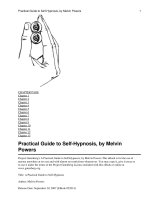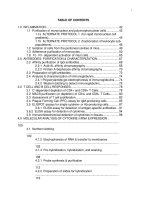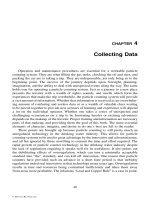A Practical Guide to Shaft Alignment phần 4 potx
Bạn đang xem bản rút gọn của tài liệu. Xem và tải ngay bản đầy đủ của tài liệu tại đây (3.12 MB, 10 trang )
31
Soft foot example: bent foot - step shim at foot c and recheck all feet
Soft foot example: pipe strain - relieve external forces
Soft foot example: squishy foot - re shim all feet with max 3 shims
and recheck
Alignment methods and practices
17
6
11
17 14
1
1
2
4
0 0
20 22
0
0
0 0
0
0
14
© 2002 PRUFTECHNIK LTD.
32
Alignment methods and practices
When eliminating soft foot follow these steps:
1) Check all four machine feet, any foot showing over 3.0 mils correct
as appropriate.
2) Examine the largest (or two largest if the same) soft foot with feeler
gauges to determine the type of soft foot. It never hurts to examine
the other feet as well, but concentrate on nding and xing the largest
problem rst.
3) Correct the condition diagnosed by shimming only one foot if any.
4) If all feet are within tolerance commence the alignment.
© 2002 PRUFTECHNIK LTD.
33
Alignment methods - Eyesight
The straightedge
This method of shaft alignment was common practice in many plants,
provided a exible coupling was used, it was considered good enough
to eyeball the alignment and bolt the machine down. The equipment is
certainly cheap and readily available.
The corrective values for the machine feet were usually estimated
according to the experience of the person carrying out the alignment.
Most often corrections at machine feet need to be repeated on a trial
and error basis before the “eyeball” alignment condition was completed.
Even then there is no certainty that the completed alignment was correct.
Since the resolution of the human eye is limited to 4.0 mils, alignment
accuracy is correspondingly limited. Additionally without having carried
out extensive checks on the tting accuracy of the coupling on the shaft,
no direct correlation between the completed alignment and the actual
alignment of the machine shafts can be made.
At best this alignment method can be described as coupling alignment
not shaft alignment as dened earlier.
© 2002 PRUFTECHNIK LTD.
34
Alignment methods - Eyesight
The feeler gauge
Although classied here as an “eyesight” method of shaft alignment the
feeler gauge method under certain circumstances and for some machines
can be perfectly acceptable. In the installation and alignment of turbine
sets where the coupling half is an integral part of the rotor shaft and
has no exible elements, it is possible for a skilled turbine engineer to
align the two coupling halves very accurately. (As noted in the section
on alignment tolerances, no allowance for offset or gap is permissible
on these “solid” type of couplings)
Using the feeler gauge or a vernier caliper the engineer accurately
measures any gap between the coupling halves. Lift oil is then used
to rotate the shafts together through 180 degrees and the “gap” is then
checked again (with the lift oil off). This procedure is then carried out
for the horizontal alignment measurements.
© 2002 PRUFTECHNIK LTD.
35
Readings are usually graphically plotted to establish alignment
condition and any necessary corrections that are required. In some cases
engineers will rotate one shaft through 180 degrees and take additional
readings, these readings are then averaged to eliminate any possible
shaft machining errors. The averaged readings form the basis for the
alignment graph.
On machines that employ exible elements in the coupling design, the
use of feeler gauges is beset with the same limitations as the straightedge
method and can only be described as coupling alignment.
Alignment methods - Eyesight
© 2002 PRUFTECHNIK LTD.
36
Alignment methods - Dial indicators
The use of dial indicators for the vast majority of shaft alignment tasks
where a exible coupling element is used represents a substantial step
forward in accurate shaft alignment methods. There are a number of
dial set ups that can be used to effect the alignment of machines, this
section will review some of these, however, there are also a number of
factors that the engineer should take into account before embarking on
a dial indicator alignment task.
Indicator bracket sag: This should always be measured
before actual alignment readings are taken - no matter how
solid the bracket appears. See section on measuring sag.
Internal friction / hysteresis: Sometimes the gauge has to
be tapped in order for the indicator needle to settle on its
nal value.
1 mil resolution: Up to 0.5 mil rounding error may occur
with each reading. This may be compounded several times
in a full set of readings.
Reading errors: Simple errors occur when dials are read
under difcult conditions and severe time constraints.
Play in mechanical linkage: slight amounts of play may
go unnoticed but will produce large reading errors.
Tilted dial indicators: The gauge may not be mounted
perpendicular to the measurement surface so that part of
the displacement reading is lost.
Axial shaft play: This will affect face readings taken to
measure angularity unless two axial gauges are used.
© 2002 PRUFTECHNIK LTD.
37
Alignment methods - Dial indicators
Rim and Face Method - By trial and error
The interpretation of shaft alignment readings using dial indicators,
taking factors such as bracket sag into consideration requires an
elementary understanding of maths and geometry. In some cases these
skills are limited and a rough trial and error procedure is used where
bracket sag and shaft oat are ignored. Additionally only one shaft is
rotated during the measurement adding errors to the alignment caused
by coupling run-out and shaft bending.
The above sketch illustrates the scenario. Rim and face indicators touch
the xed machine coupling. Indicators are zeroed at 12 o’clock and
the machine to be moved shaft is rotated through a half turn to the 6
o’clock position. The foot nearest the coupling is raised (or lowered) by
an amount equal to half the rim indicator reading. Shims are repeatedly
placed under the foot furthest from the coupling until the face indicator
readings do not change as the shaft is rotated.
Similarly the indicators are zeroed at the 3 o’clock position and rotated
to the 9 o’clock position for the horizontal correction.
It is usually easy to spot when this procedure is used as there are often
a number of thin shims under the rear feet of the machine. Usually this
trial and error procedure results in signicant misalignment errors at the
coupling transmission planes and where possible this method should
be discouraged in favor of other dial or laser methods of alignment.
R
F
© 2002 PRUFTECHNIK LTD.
38
Alignment methods - Dial indicators
Rim and Face Method - By calculation
The measuring device for this type of alignment is a dial indicator. The
dial hand indicates, or points, to increments marked on the dial face. As
the foot is pushed into the body, the dial hand rotates clockwise. The
number of indicator marks that the hand moves is equal to the distance
that the foot was pushed into the body. When the foot travels out from
the body the dial hand similarly indicates the travel distance. The dial
count is positive when the foot travels in and negative travelling out.
Rim and Face alignment takes its name from the positions of the
indicator feet during measurements. A traditional indicator set up is
shown above.
Once mounted, the two shafts are rotated together and the dials are read
at 12:00, 3:00, 6:00 and 9:00.
Formulas for calculating alignment corrections
For such set ups, the MTBM alignment at the plane of the indicator
foot is as follows:
VO = (R6 - R0 - RS)/2 VA = (F6 - F0 - FS)/dia
HO = (R9 - R3)/2 HA = (F9 - F3)/dia
R
SL
SR
F
R = Rim
F = Face
sL = Distance from the coupling center to left feet of right m’ce
sR = Distance from the coupling center to right feet of right m’ce.
© 2002 PRUFTECHNIK LTD.
39
Shim = (F6-F0+FS)(s)/dia -(R0-R6+RS)/2
Move = (HA)(s)-HO
Move = (F9-F3)(s)/dia - (R3-R9)/2
If the dial indicators are set to zero at 12:00 and then read at 6:00, the
shim calculation becomes:
Shim = (F6+FS)(s)/dia + R6-RS/2
Positive result means add shims. Negative result means remove shims.
If the dial indicators are set to zero at 3:00 and then read at 9:00 the
MOVE calculation becomes:
Move = (F9)(s)/dia + R9/2
Positive means move toward 3:00
Negative means move toward 9:00
The Shim and Move calculations must each be done twice, once for
the front feet, and once for the back feet.
Indicator reading validity rule.
The sum of the 3 and 9 o’clock readings should equal the sum of the 12
and 6 o’clock readings. This applies to both radial and face readings.
Alignment methods - Dial indicators
© 2002 PRUFTECHNIK LTD.
40
Where:
R0 = Rim reading at 12:00 o’clock position
R3 = Rim reading at 3:00 o’clock position
R6 = Rim reading at 6:00 o’clock position
R9 = Rim reading at 9:00 o’clock position
F0 = Face reading at 12:00 o’clock position
F3 = Face reading at 3:00 o’clock position
F6 = Face reading at 6:00 o’clock position
F9 = Face reading at 9:00 o’clock position
dia = Diameter of the circle travelled by face indicator foot
RS = Sag of Rim indicator
FS = Sag of Face indicator
*
s = Span from measurement plane (rim indicator foot) to machine
foot (front or back) This value can be positive or negative
Clockwise is determined looking along shaft from MTBM towards
STAT.
Shim = (VA) (s)-VO
Alignment methods - Dial indicators
Sag
A major source of error in the above procedure is the sag of the
spanner bar. This error can affect the shim amounts to such an extent
that the machine will be grossly misaligned. To compensate for this sag,
measure it and then add the sag reading (it can be positive or negative)
to the 6:00 readings. See the above formulas.
© 2002 PRUFTECHNIK LTD.









